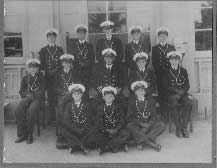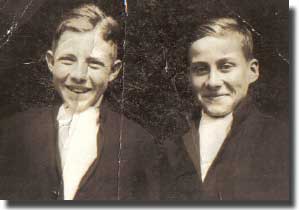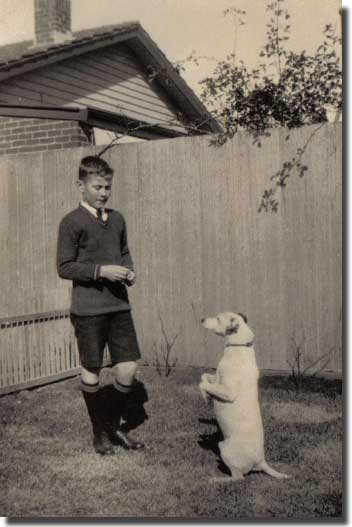|
Jervis Year. The Class of 1936. Royal Australian Naval College.
In January of 1936, 13, thirteen year old boys (click here for big picture) who were drawn from Victoria, New South Wales, and South Australia, came together as the Jervis Year, at the Royal Australian Naval College, which was located at Australia’s main Naval training depot, HMAS Cerberus at Crib Point Victoria. They had been chosen in 1935, from many applicants around Australia who undertook a written examination, then a medical examination, to finally be interviewed by a Board of Naval Officers, who had selected just 13 of them to join the Royal Australian Naval College as Cadet Midshipmen, and undergo 4 years of rigorous training to become Naval Officers in His Majesty’s Royal Australian Navy. Signing up. This group alphabetically were:
At the College, there were in all, four separate years or terms of Cadets. From the oldest fourth year to my group of first year Cadets, each separate year took the name of a well known Naval Officer, and we were known as the Jervis Year, named after Admiral John Jervis who became Earl St Vincent, and was Nelson’s Admiral at the battle of Cape St Vincent. Our year of 1936 were the 23rd. entry into the Naval College since it was founded in 1913, and as I happened to be the first in alphabetical order in my term, I was the 425th. Cadet to enter the RANC. Ian Arthur Nursey. Ian now served as an air crew member in the Middle East, was made a flight-sergeant in October 1941, but was reported missing on the 30th. of May in 1942, and was presumed to have been killed in action on that day. Four action packed years. At the end of each year, a very elaborate Passing Out Ceremony was held on the Parade Ground, performed by the all the four years of Cadets, all done without orders, but on a specific beat of the drums in the Naval Band. The finale found all the Cadets drawn up in line abreast advancing across the Parade Ground towards the saluting base, and then halting in front of it, but in a perfect line. It took a lot of training to get it absolutely right, and woe betide any Cadet stupid enough to muck up a rehearsal, let alone on the actual day. One’s behind would feel the wrath of a size ten gym shoe applied with vigor to it, for at least six wallops. The fourth year would complete their final year with a Passing out dance when girl friends would join in the festivities.
With our second term completed in our final year, we were all set to go on our final leave prior to returning to the College to complete our third and final term, face our final examinations, which included the usual secondary school subjects and French, Calculus. In addition, we had to cope with Naval Signalling, which included reading and sending messages by semaphore and morse code, knowing Naval flags and their meaning, Seamanship, Naval Engineering and Naval History. An extra requirement was the need for each Cadet to have gained the Life Saving Society’s Bronze Medallion in swimming and life saving techniques. Final Divisions. Years 3, 2 and 1 will now proceed on leave, Year 4 will remain at the College to carry out some extra courses before joining the Fleet. Leave is a privilege not a right. Cadets dismiss! After a further two weeks or so, the 12 of us proceeded to Sydney and all joined the 8 inch County Class Cruiser HMAS Canberra on the 30th. of August 1939. War is declared. Thursday the 7th. of September 1939. I was allocated to the Quarterdeck Division. Three of my term elect to become Engineering Officers. Seamanship examination for Acting Sub Lieutenant. The move from Midshipman to Sub Lieutenant is probably the largest one makes in a career as a Naval Officer. A Midshipman has been described as "The lowest form of animal life in the Navy." We all shipped our first Gold stripe on our uniforms, on passing our courses, we would be Commissioned in the Royal Australian Navy, and very importantly, our pay improved from 6 shillings a day (in todays money, 60 cents a day) to 11 shillings a day (ie 1 Dollar 10 cents today) Passage back to England. May to October 1941. At Rodean, we were fascinated to find notices still around in classrooms which read: “If you want a Mistress during the night, please ring!” Alas, as much as we pounded those bells, we were unable to elicit the wanted response. Homeward Bound. This trip, and the sinking of Tuscan Star on her next voyage will be covered in a future article to be posted on my Web Log. I was finally home after almost two years absence, arriving on Pearl Harbor Day, that infamous 7th. of December 1941, when the sneak attack by the Imperial Japanese Navy without any declaration of war, put the Allies on the final road to victory, albiet some years ahead. Scattering of the Jervis Year members. As a Sub Lieutenant, Jack Lester was killed in action in HMAS Perth in her Battle of Sunda Strait in March of 1942, and Norman White became a prisoner of the Japanese to happily survive the war. Rupert Treloar when serving as a Lieutenant in HMAS Napier was reported missing, presumed drowned on May 5th. 1943, off the east coast of Africa. We were now down to 10. Post war, Robert Scrivenor, when a Captain RAN, was involved in a car accident which killed him. Now we are 9. 50th. Anniversary of entering the RANC. We all turn eighty years of age. Max Reed organised us to all come together at the Sydney Yacht Squadron on that date for a reunion Luncheon, Sylvia, Red Merson’s wife had organised the use of a private room at the Yacht Squadron, being a member there. The wives of John Lorimer, David Nicholls, Max Reed and myself had died since our 1986 get together, I had met Denise Richards a widow, on a sunset cruise on the Zambesi River in Zimbabwe in 1994, and we married on the 14th. of August in 1999. The date chosen for our luncheon happened to be the 8th, anniversary of our first meeting back in 1994. Luncheon 15th. of July 2002. A truly wonderful meeting, topped off, when Max Reed, who had risen to become an Engineer Rear Admiral, and now in retirement, dabbled as a very competent metal smith, produced for each of us, a magnificently crafted silver spoon with a twisted stem design, and topped with an exquisite Naval Crown. Each spoon was engraved with our Jervis Year Number, in alphabetical order we were known as J1 to J12, and this number was used to identify footware, clothing etc, I was J1, so my spoon has that engraved on it at the top, a truly masterful touch, and a tremendous and generous gift to mark such a great reunion for us all. Conclusion. We may all be at the fag end of our lives, but long may The Jervis Year Flourish.
|




